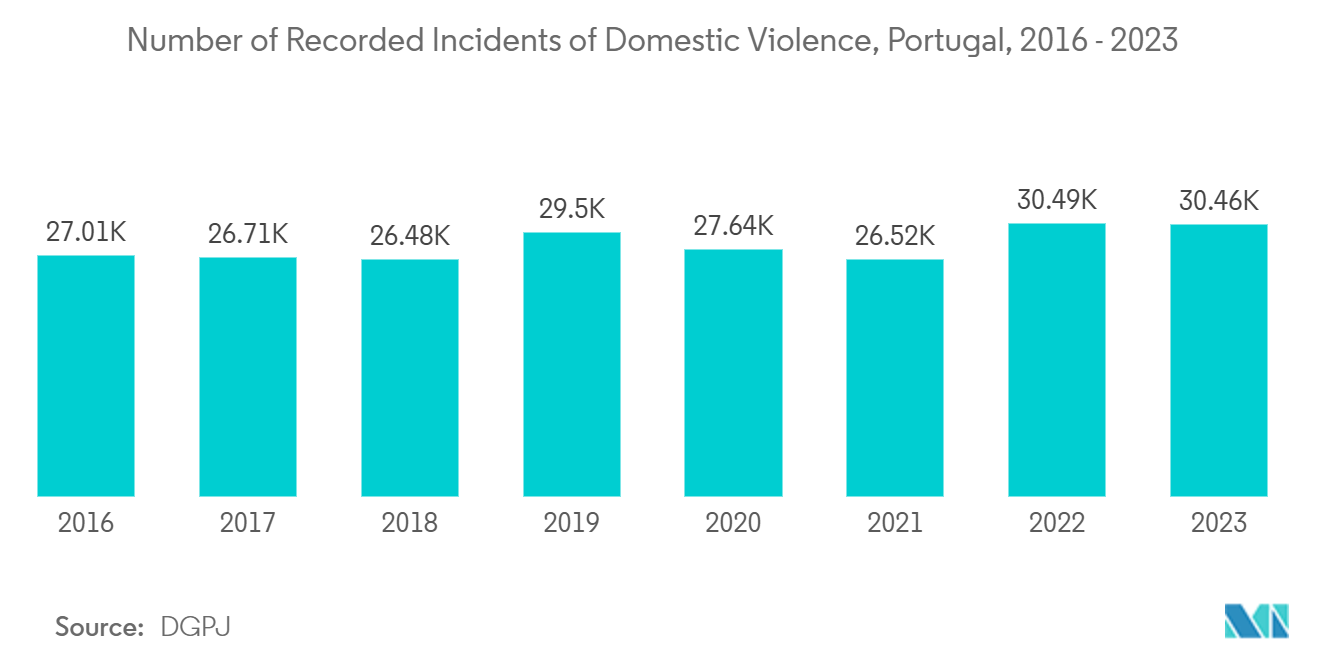Market Trends of Electronic Offender Monitoring Solutions Industry
Solutions Segment is Expected to Hold Significant Share
- The electronic offender monitoring solutions segment encompasses many features, including RF house arrest, home detention, GPS tracking, victim protection, and mobile apps for domestic violence. It also covers non-fitted solutions and monitoring for alcohol and drugs. These systems offer police, authorities, and government agencies a robust and cost-effective means to mitigate reoffending across diverse offender categories.
- As domestic violence cases rise, the demand for effective solutions grows, creating opportunities in the market. For example, data from the Government of Portugal reveals that Portugal recorded 30,461 incidents of domestic violence. While this figure shows a slight decrease from the previous year, it remains notably higher than the counts from 2016. Other countries mirror this trend. For instance, data from the Government of Mexico indicates that in 2023, Mexico reported approximately 284,203 domestic violence cases. Mexico City led with over 37,000 cases, making it the federal entity with the highest reports, trailed by Mexico State at 28,650 cases.
- Electronic offender monitoring solutions enable swift and precise offender location, aiding criminal investigations and prosecutions. Such advantages are poised to bolster the market's demand for electronic offender monitoring solutions. Numerous private firms are active in this domain, offering a suite of services from equipment development and installation to monitoring and ancillary support.
- In North America, Latin America, and select European jurisdictions, private sector companies predominantly manage electronic monitoring (EM) programs. Key electronic offender monitoring solutions market players include US-based firms like BI Inc. (part of The GEO Group, Inc.), Sentinel Offender Services, Allied Universal Electronic Monitoring, SCRAM Systems, Securus Technologies, ShadowTrack, and Track Group. Other notable companies span the globe: UK-based Buddi, Israel's SuperCom, Poland's Enigma (COMP), Switzerland's Geosatis, and Brazil's Spacecom S.A. and Synergye.
- Various companies collaborate closely with governments to provide offender monitoring solutions as per the customized requirements. For example, Fulton County Jail has recently grappled with significant challenges. The Fulton County Sheriff's Office, which manages several jails in the Atlanta vicinity, has obtained extra funding to tackle these persistent issues. They are rolling out a state-of-the-art surveillance system designed for accurate inmate tracking. Hundreds of sensors are embedded in the walls of jails throughout the region. These sensors, operating on radio frequencies, link up with wristbands worn by inmates. This advanced system, crafted by Talitrix in Georgia, boasts capabilities like monitoring an inmate's heartbeat, tracking their location every 30 seconds, and producing 3D visuals to discern individual interactions.

North America Holds Largest Market Share
- EM has solidified its position as a viable alternative to detention throughout North America. Significantly, since 2005, the U.S. has seen its reliance on EM surge nearly tenfold. This uptick in EM adoption has paralleled a notable decline in the nation's prison population.
- In recent years, enacting the First Step Act (FSA) in 2018 marked a significant pivot in U.S. criminal justice policies. This bipartisan initiative underscores a dedication to bettering outcomes, curbing federal prison numbers, and bolstering public safety. Additionally, the Reauthorization Act introduces modifications to programs that support home confinement for select elderly and terminally ill inmates. In the latter half of 2023, several studies emerged, shedding light on the effectiveness of FSA programs, particularly spotlighting segments of the prison population that were transitioned to home confinement under electronic monitoring.
- In Canada, the government initiated a program to electronically monitor federal offenders, safeguard communities, and equip the Correctional Service of Canada and police with tools to deter crime. Recently, the Alberta government rolled out an ankle bracelet monitoring initiative targeting high-risk offenders. Per the proposed Public Safety Statutes Amendment Act, 2024, those under court-ordered electronic monitoring must wear a Global Positioning System (GPS) tracking device on their ankle. This device will be under the constant surveillance of a centralized monitoring unit within Alberta Correctional Services. Such jurisdictional changes are poised to bolster the studied market demand.
- According to the Vera Institute of Justice's report, "People on Electronic Monitoring," the use of electronic monitoring (EM) in North America's criminal legal system has surged. In the U.S., over 150,000 individuals are under EM at any moment as part of state and local monitoring systems. Vera's researchers highlight a notable trend: an uptick in EM usage frequently parallels a rise in jail populations. This was evident in Detroit, Michigan, where a 41% surge in EM usage coincided with a 60% jump in jail population. The report underscores this correlation: "Most local jurisdictions with a high EM rate also had a high jail incarceration rate."
- EM is emblematic of a broader trend in the region, where governments increasingly delegate criminal and immigration supervision to private entities. A case in point: The GEO Group, Inc., a private prison firm, spearheaded a U.S. pilot initiative placing hundreds of migrants intercepted at the U.S.-Mexico border under house arrest.
- Furthermore, as of May 4, 2024, Immigration and Customs Enforcement (ICE) has seen a rapid uptick in using BI Incorporated's VeriWatch wrist-worn GPS device, marking it as their premier electronic monitoring tool. Recent figures reveal a jump from 1,441 to 2,153 immigrants under VeriWatch in just two weeks. This trend is particularly pronounced in ICE's Harlingen (324), Los Angeles (298), and Seattle (294) regions. These continuous developments and integrations have demonstrated a major inclination of North American countries towards incorporating electronic offender monitoring solutions in the region.


